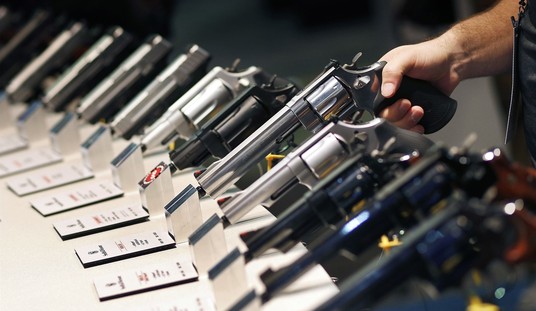Hillary Clinton has made pushing for an “assault weapon” ban (similar to the 1994 law signed by her husband which failed to have any impact on crime) a key part of her anti-gun platform.
The thing is, most Americans don’t want it.
The fewest Americans in 20 years favor making it illegal to manufacture, sell or possess semi-automatic guns known as assault rifles. Thirty-six percent now want an assault weapons ban, down from 44% in 2012 and 57% when Gallup first asked the question in 1996.
Assault rifles have been a contentious issue in American life for decades. Two years after President Bill Clinton signed a federal assault weapons ban in 1994, Gallup found that a solid majority of Americans favored such a ban. By the time the 10-year ban expired in 2004, Americans were evenly divided. And by 2011, public opinion had tilted against the assault weapons ban, with 53% opposed and 43% in favor. In Gallup’s 2016 Crime poll, conducted Oct. 5-9, opposition now exceeds support by 25 percentage points, 61% to 36%.
Perhaps paradoxically, opposition toward a ban has increased against a backdrop of multiple mass shootings and terrorist attacks in which the perpetrators used assault rifles. These guns were used in high-profile incidents, including the terrorist attacks in San Bernardino, California, and Orlando, and the mass shootings in Aurora, Colorado, and Newtown, Connecticut.
Support for Ban Wanes Among Democrats, Republicans
In the past 20 years, support for an assault weapons ban has fallen among all partisan groups, but more so among Republicans than Democrats. Currently, 50% of Democrats and 25% of Republicans favor a ban; in 1996, 63% of Democrats and 50% of Republicans did so. The partisan gap in support has doubled, from 13 points in 1996 to 25 points today.
Why has support for the banning of AR-15s, AKMs, and similar rifles plummeted?
In a word, knowledge.
When Bill Clinton signed the 1994 “Crime Bill” containing a ban on all many of scary looking firearms, they simply were not that common in American culture at the time. Your average long gun owned by an American civilian in 1994 was of the “wood and steel” variety, mostly pump shotguns, lever-action, and bolt-action rifles, and a smattering of wood-stocked semi-autos. While there were of course some military-style semi-automatic rifles on the market, (AR-15s were sold for several years to sportsmen before the M16A1 was fielded as our general service rifle) they weren’t a major force.
The 9/11 happened, and our nation went to war, first in Afghanistan, and then in Iraq.
When the 1994 assault weapon ban expired in 2004 (it had a sunset clause), it was not renewed. Servicemen and women returning from war found comfort in purchasing a civilian rifle that shared many of the same characteristics as the one they trained one, minus fully-automatic fire. Other shooters started cluing in to the fact that the AR-15 wasn’t so much a specific kind of firearm, but an open-source system that could be configured in no less than 30 calibers, as a pistol, a compact rifle, a mid-length carbine, standard rifle, or precision rifle.

12 years later, AR-15s are the best-selling rifle in the United States year after year, favored by men, women, and children, for everything from casual plinking, to many kinds of shooting sports, to home defense (indeed, many highly-respected experts feel that the AR-15 is the best home defense weapon available).

Earlier this year I wrote a post explaining why I will never give up my AR-15, no matter what paper law a petty tyrant like Hillary Clinton may try to force down the throats of the American people.
AR-15s are not “weapons of war”—they’ve never been general issue for any army in the world—but they are wonderful weapons to keep the peace and protect those I love.
A handgun is decent for close range self-defense, but as any expert will tell you, they’re a close-range, last-ditch weapon that we conceal carry in public because we simply don’t expect to meet deadly-force threats in the course of our daily lives. That’s precisely the same reason police officers only carry handguns on patrol under normal circumstances in the United States.
Shotguns have their place as well, being an incredible fight-stopper at close and medium-range engagements out to 50 yards or more, but they have low magazines capacity, stout recoil (even with solid technique, and I’ve won competitions with mine), are slower shot-to-shot, and aren’t precise.
My AR-15 allows me to confront the increasing threat of violent criminals operating in packs instead of as individuals.
We just had a home invasion in Cary this week featuring five armed thugs, including the criminal above. The family was unarmed and completely at the mercy of the criminals, who robbed them blind, took one family member hostage to a nearby ATM to clear out their bank accounts, then stole their SUV out of spite, and burned it. Don’t you think they wished they had an AR-15 to cut these thugs down as soon as they kicked in the door?
A handgun with a 7, 10, or 15-round magazine wouldn’t have given me the firepower I need to win a 5-on-1 fight. This is despite the fact my level of defensive training with a handgun is is far greater than most Americans, and my skill exceeds that of most law enforcement officers.
A shotgun—most of which only have a five-round capacity to begin with— would have left me with an empty gun.
I love my family, so my home defense firearm is an AR-15
Let’s do a quick “tour” of my home defense AR-15.
I have a simple yet effective “A2”-style flash suppressor on the end of the barrel. The slots in the flash suppressor direct burning propellant gasses away from my line of sight while also minimizing them, so that I can always see threats. Above the barrel (the rifle is on its right side in the photo) is a 500 lumen weapon-mounted light. While small, it throws a blinding amount of light, and makes it very difficult for a bad person to accurately aim a weapon at me or my family, increasing our odds of survival. It also enables me to see exactly what kind of threat I’m facing.
Moving back, you can see the front handguard that encases the barrel. It gives me a good purchase so that I can accurately aim my rifle, so I can get more precision than I could ever dream of with a handgun, ensuring I have the best possible opportunity to make accurate hits, so that I can afford to fire fewer rounds. At the back of the handguard on the upper receiver is a red-dot sight.
My red dot sight does not offer any magnification, but I when I look through it, it places a bright red dot on potential threats that only I can see, day or night. I can easily keep both eyes open with this kind of sight, enhancing my peripheral vision so I can better see both potential threats that I might need to shoot, and more importantly, innocent bystanders.
I carefully selected the cartridges I use in my home defense AR-15. The gray and black bullets are a marvel of modern technology. The gray tips are plastic, and upon striking a target, are forced back into the body of the bullet, which is a soft lead core. As the plastic tip moves backwards into the soft lead core, the bullet expands very quickly and can fragment. This has the dual effect of dumping all of the energy into the body of any threat, hopefully ending the fight quickly, which keeps my family safe, and believe it or not, actually gives the bad guy threatening a better chance at survival. If I have to shoot him more times, he has less of a chance of survival.
The rapidly expanding bullet is also safer for everyone in my home and neighborhood in the event that I miss as well. When the plastic bullet tip strikes building materials such as sheetrock or 2×4 studs or brick, it drives the tip into the lightweight core and immediately begins slowing this bullet down. It actually poses less of a risk of overpenetration through multiple walls than most common handgun bullets, or buckshot or slugs from a shotgun.
I use standard capacity 30-round magazines in my home defense AR-15. I can deliver 30 precision rounds against threats to my family as needed from every magazine. At my current skill level, I can personally deliver up to 2-3 precision shots to the center of the chest of a human threat per second at in-home distances, and transition from threat to threat in a second or less.
The faster I am able to put accurate rounds on threats to my family, the fewer shots these threats can fire at my family. The shorter the fight, the better chance my family has of surviving a home invasion.
Why on earth would any sane human being want to give violent home invaders a “fair fight” by limiting how law-abiding citizens can most effectively respond to threats on their families by increasingly large groups of criminals?
The AR-15 platform and similar rifles give men and women of every race, size, age, and physical ability (including disabled people who cannot reasonable fire handguns or shotguns) the ability to defend those lives they hold most dear.
I will not surrender my AR-15 to corrupt politicians more interested in controlling me than protecting my family, no matter what blatantly unconstitutional laws they author.
Nor will the other owners of nine million other AR-15s.
Tens of millions of Americans have reached that exact same conclusion, even if their firearm of choice isn’t the AR-15. There are also millions of AKM owners, owners of so-called battle rifles (mostly in .308, where the AR-10 is seeing a huge resurgence), pistol-caliber carbines, tactical shotguns, and tens of million more who own semiautomatic pistols.
Many, if not most of these firearms are designed to use a standard capacity magazine of 12-30 rounds.

Politicians such as Hillary Clinton—who have no firearms training at all, and who resent that gun owners are a threat—don’t want you to have these options, these features, these firearms, or this liberty which threatens her quest for power and control.

America, however, doesn’t agree with Hillary Clinton’s radical desire to ban the most common firearms and magazines in the United States.
Support for an assault weapons ban is declining everywhere, except for among radical Inside the Beltway anti-gun Democrats.
The simplest way to avoid their assault on our proverbial cartridge boxes is to vote against them at the ballot box.
Send Hillary home on November 8, or expect to spend the next four years fighting to retain your core human right to bear arms to defend your family.














Join the conversation as a VIP Member